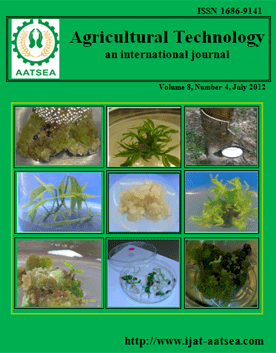ThaiScience
ThaiScience
INTERNATIONAL JOURNAL OF AGRICULTURAL TECHNOLOGY
Volume 14, No. 07, Month DECEMBER, Year 2018, Pages 1575 - 1582
Dung beetle assemblages in three human-modified landscapes in northeastern thailand
Paiboon, N., Aroon, S., Thanee, N., Jitpukdee, S. and Tantipanatip, W.
Abstract Download PDF
Dung beetles are good indicators of various terrestrial ecosystems. Their number and diversity usually associated with environmental factors. The dung beetle assemblages in degraded forest was investigated in plantation forest and agricultural land as well as their relationship with temperature, rainfall and soil properties. Results showed that a total of 3,634 dung beetles from 1 order, 1 family and 10 genera were captured. The most common genus was Copris (35.14%), followed by Onthophagus (22.62%), Heliocopris (14.45%) and Onitis (14.42%), respectively. Most dung beetles were captured from agricultural land (1,653; 45.49%) followed by plantation forest (1,028; 28.29%) and degraded forest (953; 26.22%). The number of dung beetles was not different among seasons (F = 3.126, df = 2, p > 0.05). The highest number of dung beetles was found in the summer followed by the rainy season and the winter, respectively. The number of dung beetles had positive correlation with temperature (r = 0.73, p < 0.01) and had negative correlation with soil potassium (r = - 0.7, p < 0.01). However, there were no relation between the number of dung beetles and rainfall, soil phosphorus, soil types, soil pH and organic matter.
Keywords
Dung beetle, diversity, degradged forest, plantation, farm, ThailandINTERNATIONAL JOURNAL OF AGRICULTURAL TECHNOLOGY
Published by : Association of Agricultural Technology in Southeast Asia (AATSEA)
Contributions welcome at : http://www.ijat-aatsea.com
